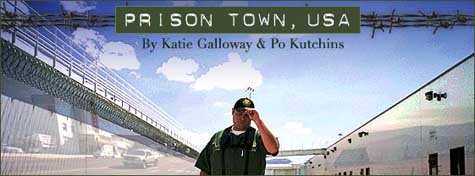"What happens when a struggling rural community tries to revive its economy by inviting prisons in?" the film asks.
 [Image: Prison Town, USA].
[Image: Prison Town, USA].In focusing on the rural "prison town" of Susanville, California, the film presents "a riveting look at one of the most striking phenomena of our times: a prison-building and incarceration boom unprecedented in American history."
Indeed, this unprecedented "incarceration boom" hit the point where, "during the 1990s, a prison opened every 15 days."
- The United States now has the dubious distinction of incarcerating more people per capita than any other country in the world. Yet this astonishing jailing of America has been little noted because many of the prisons have opened in remote areas like Susanville. Prison Town, USA examines one of the country's biggest prison towns, a place where a new correctional economy encompasses not only prisoners, guards and their families, but the whole community.
Meanwhile, in an interview with the filmmakers, we learn a bit more about this "correctional economy":
- The prison boom came in the wake of traditional industries waning for decades since the 1950s. Ranching, mining and milling got outsourced. Then, when the political climate shifted and prison expansion began, people in the towns welcomed prison officials when they said: "We're going to build a prison, it's going to create jobs, and you'll be able to count the prisoners in your census numbers." But they didn't understand that the repercussions are huge. You get a lot of money that comes in through higher wages that the guards make, but there are Wal-Marts and fast food joints that just flow in after the prison. That's part and parcel of the prison expansion, and local businesses don't get that money, the big, big corporations do, so the money doesn't even stay in Susanville.
 [Image: Prison Town, USA].
[Image: Prison Town, USA].For instance, the fact that "prisoners are counted by the census in the towns where they're imprisoned rather than the towns they call home" leads to a "huge shift of resources – political, economic, social services, et cetera – from the urban areas where most of the inmates come from to these rural areas."
Specifically, as "federal and state money moves from urban areas to rural areas," "census lines are redrawn" and otherwise insignificant little towns like Susanville can gain "a lot of political clout" by inviting this national "prison expansion" in.
In any case, I got to see a copy of the film last night, and I'd really recommend seeing it. So, if you're near a television (and in the United States) tonight, give it a shot.
Here's the trailer.
No comments:
Post a Comment